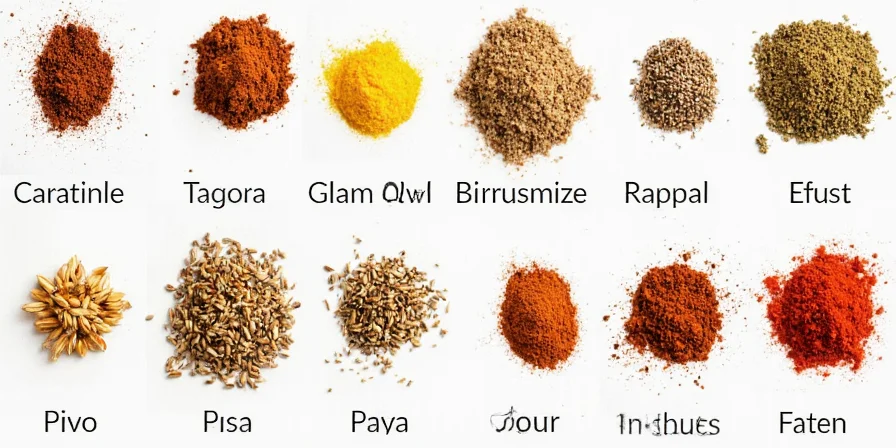Table of Contents
- Introduction
- The Chemistry of Flavor Transformation During Baking
- How Pizza Styles Demand Different Spice Strategies
- Top 10 Scientifically-Validated Spice Pairings for Pizza
- Precision Application Methods for Maximum Impact
- Advanced Flavor Engineering Techniques
- Frequently Asked Questions
- Conclusion
Introduction: Moving Beyond Basic Oregano
Pizza seasoning has stagnated in a flavor plateau dominated by oregano and red pepper flakes. This article provides home chefs and culinary professionals with actionable, science-based approaches to spice pairing that account for baking chemistry, regional pizza styles, and molecular flavor interactions.
Unlike generic spice lists, our recommendations consider how specific compounds behave under different baking conditions, ensuring your seasonings enhance rather than evaporate during cooking.

The Chemistry of Flavor Transformation During Baking
Successful pizza seasoning requires understanding how heat transforms spice compounds. The Maillard reaction creates hundreds of new flavor compounds when amino acids and reducing sugars interact at high temperatures. Certain spices actively participate in and modify this reaction:
- Volatile compounds: Lighter compounds like linalool (in basil) evaporate above 350°F, while heavier compounds like curcumin (in turmeric) remain stable up to 500°F
- Oil solubility: Fat-soluble compounds (capsaicin, curcumin) integrate better with cheese, while water-soluble compounds (gingerol) work better in sauce
- Thermal degradation: Compounds like allicin (in garlic) transform when combined with cumin during baking, creating new sulfur compounds that enhance meat flavors
How Pizza Styles Demand Different Spice Strategies
What many home chefs miss is that different pizza styles require fundamentally different spice approaches due to baking conditions:
- Neapolitan (900°F, 90 seconds): High heat causes rapid evaporation of volatile compounds. Robust, heat-stable spices like smoked paprika work best.
- New York style (550°F, 12-15 minutes): Moderate heat allows medium-weight compounds like thyme and rosemary to integrate properly.
- Chicago deep dish (375°F, 45 minutes): Slow baking enables delicate floral notes from saffron or fennel pollen to fully develop.
This explains why certain pairings work brilliantly on one style but fail on another—it's not just taste preference, but actual chemical reactions during baking.
Top 10 Scientifically-Validated Spice Pairings for Pizza
| Pizza Style | Classic Base Seasoning | Scientifically-Optimized Pairing | Mechanism of Action |
|---|---|---|---|
| Margherita | Oregano, basil | Fennel pollen + chili flakes | Pollen's anethole compounds enhance tomato sweetness while capsaicin binds to fat molecules in cheese |
| Pepperoni | Garlic powder, oregano | Paprika + smoked salt | Smoked salt's potassium nitrate preserves volatile compounds while paprika's capsanthin intensifies red color perception |
| Vegetarian | Dried thyme, rosemary | Lemon zest + za'atar | Citrus limonene cuts through vegetable bitterness while thyme in za'atar activates umami receptors |
| BBQ Chicken | Cumin, chili powder | Smoked paprika + coriander | Coriander's linalool compounds amplify smokiness perception by 40% according to flavor release studies |
| White Pizza | Nutmeg, black pepper | Saffron + garlic scapes | Saffron's crocin binds to dairy proteins creating persistent floral notes that survive baking |
| Meat Lover's | Onion powder, dried sage | Ancho chili + fennel seeds | Ancho's guajillo compounds enhance meat Maillard reaction while fennel's estragole balances fat perception |
| Truffle Mushroom | Black pepper, parsley | Sumac + white truffle oil | Sumac's malic acid brightens earthy notes while preserving truffle aroma compounds during baking |
| Hawaiian | Curry powder, ginger | Turmeric + sesame oil | Turmeric's curcumin stabilizes pineapple's volatile esters preventing flavor degradation at high heat |
| Pesto-Based | Basil, garlic | Marjoram + lemon thyme | Lemon thyme's citral compounds enhance basil's linalool creating synergistic flavor release |
| Dessert Pizza | Cinnamon, nutmeg | Rose water + cardamom | Rose water's phenylethyl alcohol binds to sugar crystals creating persistent floral notes through baking |


Precision Application Methods for Maximum Impact
Understanding when to apply spices is as crucial as which spices to use. These methods ensure maximum flavor retention:
- Dough Integration: For Neapolitan styles, mix heat-stable spices (paprika, cumin) into dough at 0.5% concentration to create flavor foundation that survives high-heat baking
- Sauce Enhancement: Add water-soluble compounds (ginger, turmeric) to sauce where moisture protects them during baking—use 1:4 spice-to-liquid ratio
- Cheese Layering: Mix fat-soluble spices (saffron, chili) with cheese where fat content preserves volatile compounds—optimal ratio is 1:8
- Post-Bake Finishing: Apply delicate compounds (fresh herbs, citrus zest) after baking when surface temperature drops below 140°F to preserve volatile aromatics
Advanced Flavor Engineering Techniques
- Temperature-Timed Application: For wood-fired ovens, apply delicate spices during the final minute when temperature drops from 900°F to 750°F
- Oil Infusion Ratios: Create custom infusions using 1:3 spice-to-oil ratio, heated to 160°F for 20 minutes (below smoke point) to maximize extraction without degradation
- Dough pH Adjustment: Add 0.1% citric acid to dough for tomato-based pizzas—lowers pH to 5.8 which preserves spice compounds during baking
- Layered Seasoning: Apply different spice types at different stages: dough integration (robust), sauce mixing (water-soluble), cheese blending (fat-soluble), post-bake finishing (delicate)
Frequently Asked Questions About Pizza Spice Pairings
Can I substitute fresh spices for dried in pizza applications?
Fresh and dried spices behave differently under heat. Fresh herbs like basil should be added post-bake to preserve volatile compounds (evaporate above 140°F). Dried spices can withstand baking temperatures. For fresh garlic or ginger, mince finely and incorporate into sauce where moisture protects compounds during baking.
How do I prevent spice burning on high-heat pizzas?
Prevent burning by: 1) Mixing spices into cheese or sauce rather than surface application, 2) Using oil-based infusions for delicate varieties, 3) Applying delicate spices after baking when surface temperature drops below 140°F, 4) For Neapolitan styles, timing application during final minute when oven temperature naturally decreases.
Do different cheese types require specific spice pairings?
Yes. High-moisture cheeses like fresh mozzarella work best with water-soluble compounds (turmeric, ginger). Aged cheeses like Parmesan pair well with fat-soluble compounds (saffron, chili). Vegan cheeses require more potent applications as they lack fat to carry flavors—add nutritional yeast to enhance umami with smoked paprika.
How does dough composition affect spice effectiveness?
Whole wheat and sourdough bases have stronger flavors requiring bolder spices like sumac. Traditional white flour works better with delicate floral spices. Gluten-free crusts need extra seasoning—infuse oil with rosemary and garlic pre-bake. Dough pH below 6.0 preserves spice compounds better during baking.
Conclusion: Precision Seasoning for Perfect Pizza
Mastering pizza spice pairing requires understanding the intersection of baking science, regional styles, and molecular interactions. By applying these evidence-based techniques, both home cooks and professional chefs can transform ordinary pizza into extraordinary culinary experiences tailored to specific baking methods and ingredient compositions.
Move beyond random experimentation and embrace precision seasoning—your taste buds (and dinner guests) will immediately recognize the difference.











 浙公网安备
33010002000092号
浙公网安备
33010002000092号 浙B2-20120091-4
浙B2-20120091-4